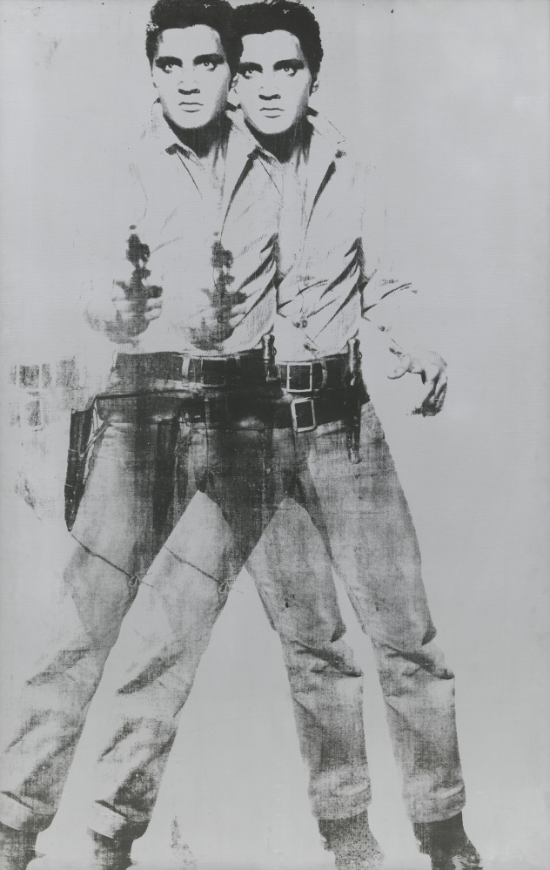Double Punk, Twinrafters. 2024.
“Double Punk” serves as an homage and evolution of Andy Warhol's 1963 silk screen painting, “Double Elvis,” using CryptoPunk #2991. Andy Warhol’s iconic work, “Double Elvis,” epitomizes his exploration of mass production, celebrity culture, and the commodification of fame. In this painting, Warhol depicts Elvis Presley, the legendary rock and roll icon, in a bold and striking manner. The repetition of Elvis’s image creates a sense of mass production and ubiquity, reflecting the consumer culture of the 1960s.
Double Elvis, Andy Warhol. 1963.
"Double Elvis" also serves as a commentary on the cult of celebrity and the power dynamics inherent in media representation. Through the repetition and distortion of Elvis's image, Warhol highlights the artificiality and constructed nature of fame, questioning the authenticity of celebrity personas and the role of the media in shaping public perception.
Despite the half-century gap, parallels can be drawn between Warhol's exploration of mass production, identity, and celebrity status and the digital assets arising from the CryptoPunks NFT project. Created by Matt Hall and John Watkinson of Larva Labs in 2017, CryptoPunks consists of 10,000 unique algorithmically generated characters, each with distinct traits and attributes. Like Warhol's repetition of Elvis's image, CryptoPunks leverages digital technology to create a vast array of individual identities within a digital ecosystem.
Warhol's influence on the CryptoPunks project is suggested through its simplistic pixel compositions, underscoring the intersection of art, technology, and culture in the digital age. By minting these unique digital collectibles on the Ethereum blockchain, CryptoPunks challenge traditional notions of ownership and authenticity in the art world, opening new possibilities for creative expression and economic exchange. This process champions the sale and distribution of metaphysical goods on a global scale.
Arguably, the phenomena of mass production and consumerism prevalent 60 years ago have reemerged, but now digital assets have taken center stage. Leading the charge, CryptoPunks played a pivotal role in the adoption and spread of instantly mass-produced and transferable digital identities through NFTs. The success of CryptoPunks spurred the creation of numerous other NFT projects, each mimicking or expanding upon the 10,000-character set in a bid to build their own fervent communities, seeking to establish identity and brand awareness.
Consequently, both "Double Elvis" and CryptoPunks delve into questions of identity and representation in an increasingly mediated and digital world. As individuals interact with and invest in these cultural artifacts, they participate in constructing meaning and value within the broader cultural landscape. For instance, the rarity of certain traits in select CryptoPunks can fetch a higher premium, potentially commanding a celebrity status. Alien and Ape punks have fetched millions of dollars in individual sales and typically direct community attention, creating a following for that Punk. Thus, the commodification of celebrity status has never been easier to attain, provided one has deep enough pockets.
Ultimately, “Double Punk” illustrates the innovations brought by Andy Warhol and the CryptoPunks project, showcasing how new technologies can resurface questions from the past. This project reengages public discourse on identity and its production, exchange, and commodification in the modern age. Through these artistic and technological advancements, both Warhol’s and CryptoPunks' works continue to provoke deeper discussions about the nature of art and its place in society.
Ethereum Transaction for Double Punkhttps://etherscan.io/tx/0x1adbe9908b42506e17b7d48c39a7eb831ac375ddbd051f69971efdee3d2e4a41
